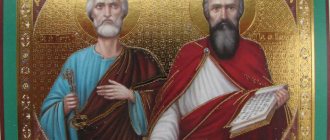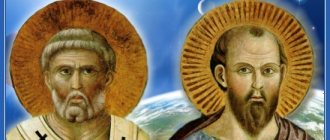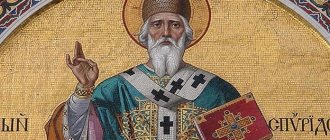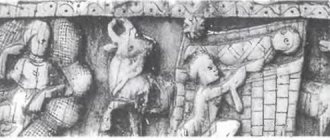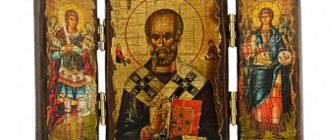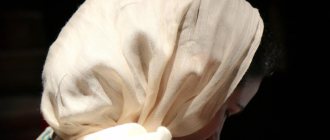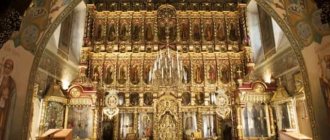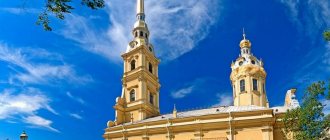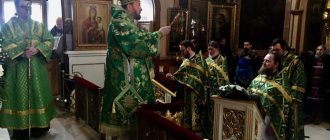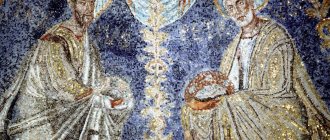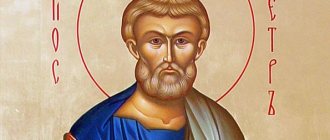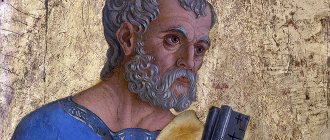"Save me, God!".
Thank you for visiting our website, before you start studying the information, please subscribe to our Orthodox community on Instagram, Lord, Save and Preserve † - https://www.instagram.com/spasi.gospodi/. The community has more than 60,000 subscribers. There are many of us like-minded people and we are growing quickly, we post prayers, sayings of saints, prayer requests, and timely post useful information about holidays and Orthodox events... Subscribe. Guardian Angel to you!
The apostles Peter and Paul are called supreme. But their championship is completely different. Peter was one of Christ’s closest disciples during earthly life, and Peter had nothing to do with these events. He began preaching much later. He was not even approved as one of the 12 apostles. And yet these two destinies are compared today.
Saint Paul
Paul's name in the world was Saul. He was the direct opposite of Peter. If he lived in a rich family, then this one was a representative of the elite. At the same time, he was a citizen of Rome by birth.
This gave him the right to many different privileges. Thanks to such privileges, he once asked for a trial from the emperor himself, thanks to which he ended up in Rome. He was educated in Jerusalem. Paul was one of the Pharisees. He tried to adhere with all accuracy to all the traditions of the elders.
The best article for you, go to: Saint Paphnutius Borovsky
The Holy Apostles Peter and Paul met when Paul set out on the road for the repentance of the infidels in Damascus. This meeting changed Saul's life forever.
It should be noted that there is very little in common between them, and probably this commonality is that in both there was a turning point in life that became decisive.
Canonical image
The Holy Apostle Peter is depicted in the icon as a wise old man with a short beard, sometimes with curly hair. His outer clothes are always golden in color, his under clothes are dark blue or blue-green. With his right hand he blesses or holds the keys of the Kingdom of Heaven. In his left hand he holds a scroll with the text or gospel words: “You are the Christ, the son of the living God” (Matthew 16: 16).
The Holy Apostle Paul on the icon is depicted with a high forehead, slightly bald, with dark hair, and a wide beard. He usually holds a scroll, sometimes as a single book or as 14 rolls tied together. His outer clothing is brown or dark purple, and his chiton is light, blue or blue-green.
Peter and Paul Day
Every year on July 12th we celebrate the day of Saints Peter and Paul. The Church especially honors this day, marking it with fasting. It should be noted that there is a special fast like this only before 3 great holidays: before Christmas, the Feast of the Dormition of the Virgin Mary and Lent before Easter.
These two apostles endured many different sufferings throughout their lives. They suffered enormous hardships.
- Peter preached with such power that 5 thousand people turned to Christ at a time.
- He healed the hopelessly sick and raised the dead. People even carried sick people out of hospitals so that his shadow would fall at least a little on the sick person and he would be healed.
- It is Peter who is the first of all the apostles to be taken into custody first.
- He suffered terrible beatings and insults from the Jews. He was thrown into prison and persecuted more than once. After he converted two of the Roman emperor's wives to Christianity, he was ordered to be crucified.
- The Apostle Paul, traveling and preaching the Gospel, wrote no less than 14 epistles that protect the Universal Church from all evil. Thanks to his eloquence and wisdom, he converted more than one thousand people to faith in Christ.
- They wanted to kill him more than once. He was chased and beaten with stones. Scarves and belts, which were taken from the apostle, healed people from illnesses and drove out evil spirits from them. The apostle also raised people from the dead.
The best article for you, go to: St. John Cassian the Roman
Since Paul was a Roman citizen, the emperor ordered him to be killed with the sword. Both apostles died on the same day, July 12, according to the new style, only with a difference of one year. Since then, the feast of Peter and Paul has been established on this date.
Brief biography
Before his calling, the Apostle Peter was called Simon; he lived the simple life of a fisherman and was a family man. Christ gave the fisherman Simon the name Peter, which means “stone” and predicted that this stone would become the basis of the entire Christian church. Peter was among those disciples whom the Savior honored to see His Transfiguration, and those who were to pray with Him in the Garden of Gethsemane.
Useful materials
Peter was the first to rush to the defense of his Teacher when messengers from the Sanhedrin came to arrest him. And Peter denied Christ three times on the night of His arrest. This happened exactly as Christ predicted, who said that the rooster would not crow before Peter would deny Him three times. Peter atoned for his apostasy with bitter and sincere repentance.
Tradition says that throughout his life, as soon as he heard the rooster crow at dawn, he began to shed tears. The Savior forgave His disciple, and Peter became one of those people to whom Christ appeared first after His Resurrection.
Apostle Peter School or art. center: Novgorod End of the 14th century. Smirnova 1976: The end of the XIV - XV centuries. Novgorod icon 1983: XV century, Obonezhye Lazarev 2000/1: End of the XIV century. 41 × 30 cm State Russian Museum, St. Petersburg, Russia Inv. 2898
After the Lord ascended into heaven, Peter began preaching. Despite the fact that he was an unlearned man, his words were so convincing and his personality so strong that the simple speech of a fisherman unskilled in rhetoric had a huge impact on people. Traveling around the countries of Palestine, Asia Minor, visiting Greece and Egypt, Peter converted thousands of new adherents to Christianity.
Through his prayer, people were healed and other miracles occurred. One day it happened that he, imprisoned in prison, was freed from his shackles and led past the sleeping guard by an angel sent by the Savior. Peter is the author of two Apostolic Epistles addressed to the Christians of Asia Minor. They were written with the aim of confirming the brothers in the faith and warning them against “false teachers” - representatives of numerous Gnostic sects and teachings, of which there were many at that time.
Peter met his death in the capital of the Empire. He preached the word of Christ here, but when the persecution of Christians began, Peter, on the advice of his disciples, decided to flee. Leaving the city, he saw his Teacher coming towards him along the road.
Icon of the Apostles Peter and Paul
On the icon of Peter and Paul, the apostles are depicted as slender figures. Peter is depicted with his right hand extended in a gesture of prayer, and Paul is holding a book in his hands. According to tradition, on the day of celebration, many people go to church, light candles and pray at their icon for:
- Good luck in starting new things,
- They ask for help in overcoming everyday problems,
- Those who doubt their decisions are asked to give hope.
Traditionally, the feast of Peter and Paul is highly revered among fishermen. This is not surprising, because the Apostle Peter is the patron saint of fishermen. And if you ask for good luck in fishing on this day, then be sure that you will not return home without a good catch of fish.
It is very important on this day to light candles at the icon and say the words of prayer quietly, but with soul. And only after this can you ask the saints for assistance in solving absolutely any everyday problems.
Prayer to Peter and Paul:
O glorification of the apostles Peter and Paul, who gave up their souls for Christ and fertilized His pasture with your blood! Hear your children's prayers and sighs, now offered by your brokenhearted hearts. Because we are darkened by lawlessness and for this reason we are covered with troubles, like clouds, but with the oil of a good life we are greatly impoverished and we are not able to resist the predatory wolf who is boldly trying to plunder the heritage of God. O strength! Bear our infirmities, do not separate from us in spirit, so that we may not be separated in the end from the love of God, but protect us with your strong intercession, may the Lord have mercy on us all, for your prayers for the sake of your prayers, may He destroy the handwriting of our immeasurable sins and may He be honored with all the saints of the blessed The Kingdom and Marriage of His Lamb, to Him be honor and glory, and thanksgiving and worship, forever and ever. Amen.
The Lord is always with you!
The best article for you, go to: Bethlehem icon meaning and what it helps with
Watch a video about the holy apostles Peter and Paul:
What does the prayer to the apostles help with and what does it protect against?
Prayer to the holy apostles Peter and Paul protects the person praying from any wavering in faith. The Lord, through the prayers of the holy apostles, delivers from lack of faith, delusions, and the fall. Each of them is especially patronizing in different situations, but any of your prayers and requests will be heard and transferred to the Lord if the person praying says them from a pure heart with repentance and humility.
The Apostle Paul is especially helpful in the following:
- Gentiles and atheists must find true faith;
- Those who have lost the correct faith should return to the bosom of the Church;
- In healing from mental and physical illnesses;
- In teaching, especially in complex sciences.
The Apostle Peter patronizes the following:
- Opening your own business;
- Sends hard work and determination;
- Helps solve financial problems.
- Helps with fishing, since Peter himself was a fisherman.
Iconography
One of the earliest canonical icons of the Apostle Peter is located in the Sinai Monastery of St. Catherine, and dates back to the 4th century. This icon is made using the encaustic technique, i.e., painted with hot wax paints.
In the icon you can see a gray-haired man with a short beard, with a very attentive, thoughtful look and general facial expression. The Apostle holds the scrolls as a sign of his service in spreading the faith of Christ and the cross, as a symbol of the fact that he was faithful to the word of the Lord until the end of his life and carried out the confession of his faith to the end. A very similar image of the Apostle Peter can be seen in the Basilica of San Vitale in Ravenna.
Apostle Peter VI century. Frühe Ikonen 1972: 7th century. Essays on the history of art 1987: VI century. Βοκοτοπουλος 1995: Second half of the 6th - beginning of the 7th centuries. Bayet 2009: VI century. To the origins 2009: VI century. Encaustic icon 92.8 × 53.1 cm
In early Christian times, constant attributes appeared in the form of a scroll and keys, as a sign that Peter was the gatekeeper of Paradise. This is how Peter appears already in the very first ancient Russian icons. These include the 11th century Novgorod icon of Peter and Paul, presumably brought by Prince Vladimir from Korsun.
Life of Peter
The Apostle Peter, who previously had the name Simon, was born in Bethsaida, was a simple fisherman together with his brother Andrew (he was a disciple of John the Baptist), and a married man. Fishing took place mainly at night; during the day there was other work, but the family had to be fed. And the fisherman’s income was very unpredictable - everything depended on luck. Life was difficult for the Galilean fishermen. Andrew, being a disciple of John the Baptist, heard from his teacher the words that the Messiah had come - Christ. And he brings his brother Simon to Christ, whom the Lord names Cephas (in Greek - Peter), which means stone.
From that moment, Peter completely changes his life, he accompanies Christ everywhere, sees the healings performed by Christ. One of the first healings of Christ was the healing of the apostle’s mother-in-law, who was suffering from fever. Peter still continued to fish, and one day the Lord entered Peter’s boat to preach, since there was a great crowd of people. At the end of the sermon, Christ saw that the fishermen had no catch at all, even though they had worked all night. And the Lord orders them to go further into the sea and cast their nets. They obeyed, and the catch was so great that the nets were broken. Seeing the power of Christ, Peter fell to his knees before Him, and the Lord said: “Do not be afraid, from now on you will catch men!” From that moment on, Peter leaves everything - family, profession, home and relentlessly follows Christ. And, despite the fact that there was no primacy of power between the apostles, the Lord, for their zeal and fiery love, reveals to Peter, John and James the most amazing manifestations of the Divine nature - His Transfiguration on Mount Tabor, the resurrection of the daughter of the leader of the synagogue Jairus.
How to learn to see not only with your eyes
And after feeding five thousand people with five loaves, when the Lord walked on the waters to the boat in which the apostles were, it was Peter who went to meet Christ also on the waters, but then, overcome by fear, he began to drown, to which Christ said: “Why did you doubt, you of little faith? » and gave him his hand.
Peter was strikingly different from the rest in his immeasurable love for Christ, impulsive and ardent character. To Christ’s question to the apostles: “Who do you say I am?” Peter was the first to exclaim: “You are the Christ, the Son of the living God.” Seeing such a living confession of faith, the Lord says: “You are Peter, and on this rock I will build My Church and the gates of hell will not prevail against it.” But when Christ told the apostles about His coming suffering on the cross, the Resurrection from the dead, here Peter, showing human weakness, says: “Lord! Let this not happen." To which the Savior replies: “Get away from me, Satan! You are not thinking about what is God’s, but what is human!”
During the Last Supper, in response to Peter’s ardent assurances that if anyone would betray the Lord, it would not be him, the Lord sadly notes that that same night, before the rooster crows twice, Peter will deny Him three times. And, as we see from the Gospel, when they took Christ into custody and took him to the judgment seat, the Apostle Peter, who followed Christ from afar, when they asked him: “And were you with Jesus?” He answered three times: “I don’t know this man.” And the rooster crowed. Peter wept and repented bitterly about this renunciation until the end of his earthly life. After the Resurrection of Christ, it is Peter who is the first to enter the tomb, where the shrouds of the Risen Savior lay. The first of the apostles to see the Risen Lord was Peter, confessing Him as Lord three times, as if in repentant memory of his threefold renunciation. After the Ascension, it was Peter who was chosen by the apostles as the leader of the community. And when on the Day of Pentecost the Holy Spirit descended on the apostles, Peter, proclaiming to the Jews about the risen Christ, immediately led about three thousand people to repentance and faith in Christ. The Apostle Peter, performing signs and healing the sick, explained that all this is accomplished by the power of Christ the Savior, thereby leading even more people to faith.
"Apostle Peter", Rubens
Despite persecutions, beatings, and imprisonment, Peter continued to preach the word of Christ and bring not only Jews, but also pagans to faith. The preaching was not limited to Jerusalem. This includes Samaria, Lydda, Caesarea, Antioch and many other regions and cities. The Apostle Peter writes epistles to Christians, apostolic works and appoints bishops, proteges of the apostles, to serve the Lord in different countries. He is present in Jerusalem at the Assumption of the Blessed Virgin Mary. Having traveled through many countries, he receives a revelation from an Angel that he is destined to suffer for Christ by accepting death in Rome. And goes to Rome.
According to legend, Peter continues to preach in Rome, where he is arrested by order of Emperor Nero for converting his two wives to Christianity. And they are sentenced to crucifixion, to which Peter asks to be crucified head down, so that even in crucifixion he can bow his head at the feet of Christ and looking into the sky, have hope for eternal life in the Heavenly Abodes of the Kingdom of Heaven.
Shrines
After his death, Peter was canonized. On the site of his grave, the Basilica of Constantine was erected in 326, which stood for 11 centuries. At the direction of Pope Julius II, St. Peter's Cathedral was erected in place of the ancient building, and services there resumed in 1626.
The relics of the saint are located under the Papal Throne, in the crypt, which is reached down a marble staircase. Near the central nave stands a bronze statue of the apostle. After prayer, pilgrims kiss the saint’s foot. In Russia, the memory of Christ’s beloved disciple was immortalized in the names of cities:
- Saint Petersburg;
- Petropavlovsk-Kamchatsky;
- Petrozavodsk.
The Apostle is considered the patron saint of the former capital of the Russian Empire.
Apostle Peter
Before meeting Christ, who named him Cephas ("stone", or in Greek "petra"), Saint Peter's name was Simon. He was born in Bethsaida, in Galilee. His father's name was Jonah. He had a brother, Andreas, his first-born. It was Andrew who introduced Peter to Jesus after first telling him, “We have found the Messiah.” (John 1:42) Simon Peter was married and engaged in fishing, his true passion. This activity helped him withstand the storms of life, taught him to work hard, rejoice in successes and endure failures with fortitude. Simon had a dynamic, spontaneous and easy-going character.
The meeting with Jesus from Nazareth changed his life forever, because from an ordinary fisherman Christ made him a “fisherman of men,” that is, an apostle gathering people around him for the Kingdom of Heaven, which was preached by St. John the Baptist and then Jesus, saying: “Repent, for it has come near.” Kingdom of Heaven" (Matthew 4:7).
Did the Apostle Peter grow up in the Jewish faith? inherited from his family - in the synagogue, in the Jewish and slightly Hellenistic environment of Galilee, where different faiths coexisted. Yet Simon Peter was a simple man, he did not speak Greek, and therefore he had a disciple - John Mark, who, as an assistant, translated for him from Hebrew into Greek.
